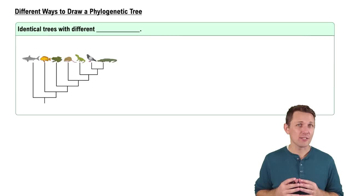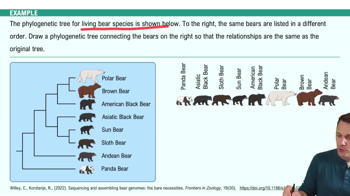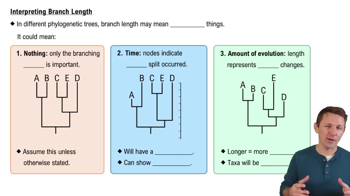Table of contents
- 1. Introduction to Biology2h 40m
- 2. Chemistry3h 40m
- 3. Water1h 26m
- 4. Biomolecules2h 23m
- 5. Cell Components2h 26m
- 6. The Membrane2h 31m
- 7. Energy and Metabolism2h 0m
- 8. Respiration2h 40m
- 9. Photosynthesis2h 49m
- 10. Cell Signaling59m
- 11. Cell Division2h 47m
- 12. Meiosis2h 0m
- 13. Mendelian Genetics4h 44m
- Introduction to Mendel's Experiments7m
- Genotype vs. Phenotype17m
- Punnett Squares13m
- Mendel's Experiments26m
- Mendel's Laws18m
- Monohybrid Crosses19m
- Test Crosses14m
- Dihybrid Crosses20m
- Punnett Square Probability26m
- Incomplete Dominance vs. Codominance20m
- Epistasis7m
- Non-Mendelian Genetics12m
- Pedigrees6m
- Autosomal Inheritance21m
- Sex-Linked Inheritance43m
- X-Inactivation9m
- 14. DNA Synthesis2h 27m
- 15. Gene Expression3h 20m
- 16. Regulation of Expression3h 31m
- Introduction to Regulation of Gene Expression13m
- Prokaryotic Gene Regulation via Operons27m
- The Lac Operon21m
- Glucose's Impact on Lac Operon25m
- The Trp Operon20m
- Review of the Lac Operon & Trp Operon11m
- Introduction to Eukaryotic Gene Regulation9m
- Eukaryotic Chromatin Modifications16m
- Eukaryotic Transcriptional Control22m
- Eukaryotic Post-Transcriptional Regulation28m
- Eukaryotic Post-Translational Regulation13m
- 17. Viruses37m
- 18. Biotechnology2h 58m
- 19. Genomics17m
- 20. Development1h 5m
- 21. Evolution3h 1m
- 22. Evolution of Populations3h 52m
- 23. Speciation1h 37m
- 24. History of Life on Earth2h 6m
- 25. Phylogeny2h 31m
- 26. Prokaryotes4h 59m
- 27. Protists1h 12m
- 28. Plants1h 22m
- 29. Fungi36m
- 30. Overview of Animals34m
- 31. Invertebrates1h 2m
- 32. Vertebrates50m
- 33. Plant Anatomy1h 3m
- 34. Vascular Plant Transport2m
- 35. Soil37m
- 36. Plant Reproduction47m
- 37. Plant Sensation and Response1h 9m
- 38. Animal Form and Function1h 19m
- 39. Digestive System10m
- 40. Circulatory System1h 57m
- 41. Immune System1h 12m
- 42. Osmoregulation and Excretion50m
- 43. Endocrine System4m
- 44. Animal Reproduction2m
- 45. Nervous System55m
- 46. Sensory Systems46m
- 47. Muscle Systems23m
- 48. Ecology3h 11m
- Introduction to Ecology20m
- Biogeography14m
- Earth's Climate Patterns50m
- Introduction to Terrestrial Biomes10m
- Terrestrial Biomes: Near Equator13m
- Terrestrial Biomes: Temperate Regions10m
- Terrestrial Biomes: Northern Regions15m
- Introduction to Aquatic Biomes27m
- Freshwater Aquatic Biomes14m
- Marine Aquatic Biomes13m
- 49. Animal Behavior28m
- 50. Population Ecology3h 41m
- Introduction to Population Ecology28m
- Population Sampling Methods23m
- Life History12m
- Population Demography17m
- Factors Limiting Population Growth14m
- Introduction to Population Growth Models22m
- Linear Population Growth6m
- Exponential Population Growth29m
- Logistic Population Growth32m
- r/K Selection10m
- The Human Population22m
- 51. Community Ecology2h 46m
- Introduction to Community Ecology2m
- Introduction to Community Interactions9m
- Community Interactions: Competition (-/-)38m
- Community Interactions: Exploitation (+/-)23m
- Community Interactions: Mutualism (+/+) & Commensalism (+/0)9m
- Community Structure35m
- Community Dynamics26m
- Geographic Impact on Communities21m
- 52. Ecosystems2h 36m
- 53. Conservation Biology24m
25. Phylogeny
Phylogeny
Problem 4c
Textbook Question
Which of the following is an example of homoplasy? a. hair in humans and fur in mice b. astragalus ankle bones in hippos and deer c. Hox genes in humans and flies d. streamlined bodies in dolphins and ichthyosaurs
 Verified step by step guidance
Verified step by step guidance1
Identify the definition of homoplasy: Homoplasy refers to a trait that has evolved independently in different species, not due to a common ancestor but due to similar environmental pressures or evolutionary paths.
Analyze each option to determine if it represents homoplasy: a) Hair in humans and fur in mice - This is not an example of homoplasy as both traits are likely inherited from a common mammalian ancestor. b) Astragalus ankle bones in hippos and deer - This is also not an example of homoplasy; both species are ungulates and share a common ancestor. c) Hox genes in humans and flies - This is not homoplasy; Hox genes are highly conserved across many species due to common ancestry. d) Streamlined bodies in dolphins and ichthyosaurs - This could be an example of homoplasy as these species do not share a close common ancestor but have developed similar body shapes due to similar aquatic lifestyles.
Determine which option best fits the definition of homoplasy: From the analysis, option d (streamlined bodies in dolphins and ichthyosaurs) fits the definition of homoplasy because these traits evolved independently in response to similar environmental challenges, not due to a shared ancestor.
Conclude that the correct answer is: d. streamlined bodies in dolphins and ichthyosaurs
Understand the importance of homoplasy in evolutionary biology: Recognizing homoplasy helps biologists understand how different species adapt to similar environments through convergent evolution, highlighting the dynamic and complex nature of evolutionary processes.
 Verified video answer for a similar problem:
Verified video answer for a similar problem:This video solution was recommended by our tutors as helpful for the problem above
Video duration:
3mPlay a video:
Was this helpful?
Key Concepts
Here are the essential concepts you must grasp in order to answer the question correctly.
Homoplasy
Homoplasy refers to a trait that is shared by a group of organisms but did not originate from a common ancestor. This can occur through convergent evolution, where different species independently evolve similar traits as adaptations to similar environments or ecological niches.
Recommended video:
Guided course

Homology and Homoplasy
Convergent Evolution
Convergent evolution is the process where organisms from different evolutionary backgrounds develop similar traits or adaptations in response to similar environmental challenges. This phenomenon highlights how similar selective pressures can lead to analogous structures, despite different ancestral origins.
Recommended video:
Guided course
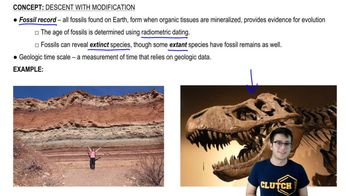
Convergent and Divergent Evolution
Analogous Structures
Analogous structures are body parts in different species that perform similar functions but do not share a common evolutionary origin. These structures arise from convergent evolution and illustrate how different species can adapt similarly to their environments, despite their distinct lineages.
Recommended video:
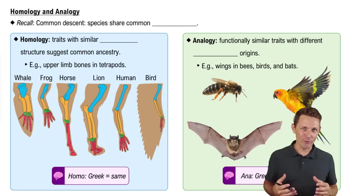
Homology and Analogy

 7:10m
7:10mWatch next
Master Reading a Phylogenetic Tree with a bite sized video explanation from Bruce Bryan
Start learningRelated Videos
Related Practice








